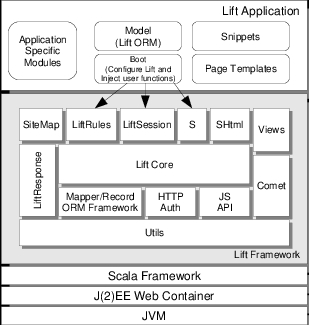CSC/ECE 517 Fall 2014/ch1a 4 wl: Difference between revisions
Jump to navigation
Jump to search
No edit summary |
No edit summary |
||
| Line 1: | Line 1: | ||
WEB DEVELOPMENT USING LIFT | WEB DEVELOPMENT USING LIFT | ||
==Features of Lift == | |||
# LazyLodading: Lift supports lazy loading of a snippet. This is useful when a snippet may take a long time to render, but it is required to return the page to the browser quickly. | |||
# Parallel Page rendering: Executing multiple snippets in parallel is possible in Lift. Multiple jobs or processes can be spawned and run in parallel. However only when all the tasks or jobs are complete the final page render is sent back to the browser. | |||
# Comet and Ajax support: Comet along with Ajax supports the asynchronous updates from user to the server or from server back to the user. | |||
# Wiring: The relationship between different elements on a page is defined through Lift Wiring. When any element on a page changes, the dependent items are displayed on the next HTTP response. | |||
# Security: Lift apps are not vulnerable to the common security concerns. Lift has built-in safeguards to combat vulnerabilities like Injection, XSS, Direct Object references and URL access | |||
== Lift Web Framework == | == Lift Web Framework == | ||
Revision as of 00:26, 20 September 2014
WEB DEVELOPMENT USING LIFT
Features of Lift
- LazyLodading: Lift supports lazy loading of a snippet. This is useful when a snippet may take a long time to render, but it is required to return the page to the browser quickly.
- Parallel Page rendering: Executing multiple snippets in parallel is possible in Lift. Multiple jobs or processes can be spawned and run in parallel. However only when all the tasks or jobs are complete the final page render is sent back to the browser.
- Comet and Ajax support: Comet along with Ajax supports the asynchronous updates from user to the server or from server back to the user.
- Wiring: The relationship between different elements on a page is defined through Lift Wiring. When any element on a page changes, the dependent items are displayed on the next HTTP response.
- Security: Lift apps are not vulnerable to the common security concerns. Lift has built-in safeguards to combat vulnerabilities like Injection, XSS, Direct Object references and URL access
Lift Web Framework
Components
- LiftCore: This is the web processor of the framework which handles the following functions.
- Request/Response
- Rendering Pipeline
- Invoking User Functions
- LiftRules : Lift Configuration
- LiftSession: Inherent Session State.
- S: stateful context for request/response lifecycle.
- SiteMap: contains web pages for the lift application.
- SHtml: helper functions for XHtml.
- Views: Views as XML content. Allows composing views from not only html files but other contexts too.
- LiftResponse: Abstraction of response sent to the client.
- Comet: allows sending asynchronous content to browser.
- ORM: A specialized library.
- HTTP Auth: provides control over authentication model.
- JS API: JavaScript abstraction layer.<ref name=explore>Exploring Lift Framework</ref>
Getting Started
Set Up on Eclipse
- Download “Scala IDE for Eclipse” : http://scala-ide.org/
- Install plugin in Eclipse from this update site : http://download.scala-ide.org/sdk/helium/e38/scala211/stable/site
- Once the plugin is installed restart Eclipse
- Install sbteclipse by adding the following to projects/plugins.sbt in your Lift Project:
addSbtPlugin("com.typesafe.sbteclipse" % "sbteclipse-plugin" % "2.5.0") - You can then create Eclipse project files (.project and .classpath) by entering the following into the SBT prompt:
eclipse<ref name=cookbook>The Lift Cookbook</ref>
Basic Web Application Structure
Step 1: Making a SiteMap entry
Every page on the site needs a SiteMap entry.
def sitemap(): SiteMap = SiteMap(
Menu("Home") / "index",
Menu("Second Page") / "second"
)
Step 2: Creating the view
Create an HTML file that corresponds to the sitemap entry.
<meta content="text/html; charset=UTF-8" http-equiv="content-type">
<title>Home</title>
<div id="main" class="lift:surround?with=default&at=content">
<div>
Hi, I'm a page that contains the time:
<span class="lift:TimeNow">??? some time</span>.
</div>
<div>
And a button: <button class="lift:ClickMe">Click Me</button>.
</div>
</div>
Step 3 : Creating the Snippet
A snippet can be thought of as a controller which has rules for transforming the section of your template.
package code
package snippet
import net.liftweb._
import util._
import Helpers._
object TimeNow {
def render = "* *" #> now.toString
}
<ref name=simplylift>Simply Lift</ref>
Advantages
- Built on Scala which is a powerful functional language.
- Multiple Component support : Divides the controls into snippets which can be used together on a single page thereby not coupling a page with a controller.
- CSS Binding : allows to navigate the HTML Dom tree.
- Native Javascript/Ajax Support
- Out-of-box Security.
- Lazy Loading & Parallel Page rendering : Lift shows automatic spinners on area still being loaded, components are able to load over multiple thread at the same time.<ref name=benefits>Why Lift Webframework is my favorite.</ref>
Disadvantages
- Lots of state kept in session.
- Learning Curve as no more MVC.
<ref name=quora>Comparison on Quora</ref>
References
<references></references>
